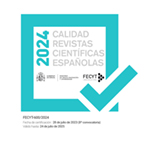Metaphorical dimension of idioms in TV series for German, Norwegian and Spanish audiences
Resumen
Las series de TV por internet se han convertido en uno de los productos audiovisuales de mayor audiencia a nivel mundial. La crisis ocasionada por el Covid con limitaciones de movimiento han incrementado su éxito durante 2020-21. El inglés es con diferencia el idioma original de estas series, que llega a los espectadores no anglófonos, en formato traducido, con subtítulos o doblaje. Uno de los retos fundamentales en la traducción es el de las locuciones, ya que no siempre tienen un equivalente fijo en la lengua meta. Tomando como punto de partida de la investigación un corpus de cuatro series de drama, ofrecidas por Netflix y Amazon Prime, este trabajo estudia la dimensión metafórica de las locuciones en series de TV originales en inglés y en los subtítulos en alemán, noruego y español. El objetivo es analizar las estrategias utilizadas en el proceso de traducción y estudiar las diferencias entre los diálogos originales y los subtítulos traducidos al alemán y a las otras lenguas meta. Los datos se describen desde una perspectiva cognitiva y contrastiva, de acuerdo con la metodología desarrollada por la autora. Los resultados del análisis muestran una tendencia general hacia la reducción de expresiones metafóricas en los subtítulos traducidos. El análisis contrastivo pone de relieve que existen diferencias significativas entre las traducciones a las tres lenguas meta. Sorprendentemente encontramos más similitudes entre las traducciones al alemán y al español que entre aquellas al alemán y al noruego, a pesar de pertenecer estas dos últimas a la misma familia lingüística de las lenguas germánicas.
Descargas
Descarga artículo
Licencia
La revista Estudios de Traducción, para fomentar el intercambio global del conocimiento, facilita el acceso sin restricciones a sus contenidos desde el momento de su publicación en la presente edición electrónica, y por eso es una revista de acceso abierto. Los originales publicados en esta revista son propiedad de la Universidad Complutense de Madrid y es obligatorio citar su procedencia en cualquier reproducción total o parcial. Todos los contenidos se distribuyen bajo una licencia de uso y distribución Creative Commons Reconocimiento 4.0 (CC BY 4.0). Esta circunstancia ha de hacerse constar expresamente de esta forma cuando sea necesario. Puede consultar la versión informativa y el texto legal de la licencia.









